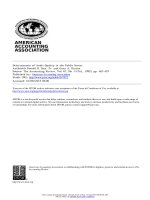Indicators of Microbial Quality in Recreational Waters
Bạn đang xem bản rút gọn của tài liệu. Xem và tải ngay bản đầy đủ của tài liệu tại đây (3.35 MB, 152 trang )
INDICATORS OF MICROBIOLOGICAL QUALITY IN
RECREATIONAL WATERS
HO DANLIANG
(B.Sc. (Hons), NUS)
A THESIS SUBMITTED
FOR THE DEGREE OF MASTER OF SCIENCE
DEPARTMENT OF MICROBIOLOGY
NATIONAL UNIVERSITY OF SINGAPORE
2014
i
Declaration
I hereby declare that the thesis is my original work and it has been written by me in its
entirety. I have duly acknowledged all the sources of information which has been used in the
thesis.
This thesis has also not been subrnitted for any degree in any university previously.
'4
1
Ho Danliang
06 lanuary 2014
Acknowledgements
My heartfelt thanks goes to my supervisor, A/P Lee Yuan Kun for his invaluable guidance and kind
encouragement throughout the course of my research. I thank him especially for challenging me to
think further and deeper about my work, for engaging me in new ideas, for giving me intellectual
freedom to conduct my own research, and on the overall for grooming me to become a better scientist.
I would like to thank our collaborator on the other aspect of our project, Dr Karina Gin from the
Department of Civil and Environmental Engineering, for her interest and support in our research, and
her group members Dr Goh Shin Giek, Dr Saied Rezaeinejad, Mr Fang Haoming, Ms Liang Liang
and Ms Genevieve Gabrielle Vergara for sharing their knowledge, equipment and reagents with us.
My thanks goes to Ms Jennifer Yap and Ms Soh Liting from National Environmental Agency (NEA),
Dr Lim Tien Tze and Ms Chang Siao Yun from Public Utilities Board (PUB) for their interest and
input in this project, as well as for their generous sharing of experiences.
My sincere gratitude goes to my mentor, Dr Koh Yiling, Eileen, for teaching me necessary laboratory
and research skills ('tricks of the trade') in the first few months of my research candidature, and for
providing guidance and advice in the nitty-gritty details of study design, benchwork as well as
bioinformatics analysis. I would also like to thank her for her leadership, friendship and
companionship; without which our laboratory would not be like what it is now.
I am deeply indebted to Mr Low Chin Seng for his assistance and support in the logistic and technical
aspects of conducting my experiments and fieldwork. I would like to thank him for being a fatherfigure to me in a laboratory setting, for his genuine care and concern (albeit under a rough exterior),
and also for unselfishly imparting me his skills and knowledge.
All results described in this thesis were accomplished with the help and support of members of the
'Water Group': Eileen Koh, Henry Teo, Siti Radiah. I would like to thank them for fighting this battle
with me till the end, for helping me accomplish the impossible, and all in all for making my research
stint an enjoyable and memorable experience.
I would like to thank the other members of our laboratory for their wonderful guidance and constant
friendship: the post-docs Dr Shen Hui and Dr Ng Yikai for their patience in answering all my queries,
fellow graduate students Lin Huixin, Daphne Ng, Kelvin Koh, Zhao Ran, Yao Lina, Kenneth Tan for
their comradeship, banter, and all the heated discussions on how my research should proceed, our ex
and current honours students Chen Kang Ting, Huang Ningxin, Regina Ang, Angela Lim, Lee
Huiting, Yow Kok Siang, Ang Sze Chien, Jolene Phua for their precious friendship and for generating
much-needed laughter in an otherwise monotonous laboratory setting.
Lastly but not least, my family members and my husband, Lim Suang, for their unwavering love and
support. This work is dedicated to them.
iii
Table of contents
DECLARATION ................................................................................................................................... ii
ACKNOWLEDGEMENTS ................................................................................................................... iii
TABLE OF CONTENTS ....................................................................................................................... iv
LIST OF TABLES ............................................................................................................................... viii
LIST OF FIGURES ............................................................................................................................... ix
LIST OF ABBREVIATIONS ................................................................................................................ xi
SUMMARY ......................................................................................................................................... xiv
CHAPTER 1: INTRODUCTION ........................................................................................................... 1
1.1 Overview of recreational water quality..................................................................................... 1
1.2 Recreational water quality assessment...................................................................................... 2
1.3 Limitations of current methods of water quality monitoring ................................................. 3
1.4 Research objectives ..................................................................................................................... 3
1.5 Scope of study .............................................................................................................................. 4
CHAPTER 2: LITERATURE REVIEW ................................................................................................ 6
2.1 Waterborne diseases ................................................................................................................... 6
2.1.1 Overall prevalence and epidemiology of waterborne diseases ......................................... 6
2.1.2 Health criteria of waterborne pathogens ........................................................................... 7
2.1.2.1 Aeromonas hydrophilia..................................................................................... 7
2.1.2.2 Escherichia coli O157....................................................................................... 8
2.1.2.3 Legionella pneumophila.................................................................................... 9
2.1.2.4 Mycobacterium avium complex ...................................................................... 10
2.1.2.5 Pseudomonas aeruginosa ............................................................................... 11
2.1.2.6 Staphylococcus aureus .................................................................................... 12
2.2 Indicator approach ................................................................................................................... 13
2.2.1 Historical background and current status ........................................................................ 13
2.2.2 Attributes of an ideal indicator ....................................................................................... 15
2.2.2.1 Biological attributes ........................................................................................ 15
2.2.2.2 Method attributes ............................................................................................ 16
2.2.3 Limitations of traditional indicators ................................................................................ 16
2.2.4 Alternative indicators ...................................................................................................... 18
iv
2.2.4.1 Fecal anaerobes ............................................................................................... 18
2.2.4.2 Chemical compounds ...................................................................................... 19
2.2.5 Classical methods of bacterial indicator detection .......................................................... 19
2.2.5.1 Multiple-tube fermentation technique............................................................. 20
2.2.5.2 Membrane filtration technique ........................................................................ 21
2.2.6 Emerging methods in indicator detection ....................................................................... 21
2.2.6.1 Immunological methods.................................................................................. 22
2.2.6.2 Real-time PCR ................................................................................................ 22
2.2.7 Issues with molecular detection of indicators ................................................................. 23
2.2.7.1 Differentiating cell viability ............................................................................ 23
2.2.7.1 Overcoming PCR inhibition ........................................................................... 24
2.3 Direct pathogen monitoring ..................................................................................................... 25
2.3.1 Phylogenetic analysis using 16S ribosomal RNA gene .................................................. 26
2.3.2 DNA microarrays ............................................................................................................ 27
2.3.3 Sequencing studies .......................................................................................................... 28
2.3.3.1 Next-generation sequencing overview ............................................................ 28
2.3.3.2 Application to metagenomics and pathogen detection.................................... 29
2.3.3.3 Bioinformatics ................................................................................................ 30
CHAPTER 3: QUANTIFYING MOLECULAR MARKERS AS INDICATORS OF WATERBORNE
PATHOGENS ................................................................................................................ 31
3.1 Introduction ............................................................................................................................... 31
3.2 Materials and methods ............................................................................................................. 32
3.2.1 Sample collection and processing ................................................................................... 32
3.2.1.1 Study sites ....................................................................................................... 32
3.2.1.2 Sampling procedures ....................................................................................... 35
3.2.1.3 Chemical tests ................................................................................................. 35
3.2.1.4 Membrane filtration ........................................................................................ 35
3.2.1.5 DNA extraction from water samples .............................................................. 36
3.2.2 Real-time polymerase chain reaction (qPCR) analysis ................................................... 36
3.2.2.1 Reference strains used in standards ................................................................ 36
3.2.2.2 Development of plasmid standards ................................................................. 37
3.2.2.3 Validation of primer set using end-point PCR ................................................ 38
3.2.2.4 Validation of primer set using real-time PCR ................................................. 41
3.2.2.5 Real-time PCR of samples .............................................................................. 42
3.2.2.6 Data analysis ................................................................................................... 43
3.2.3 Differentiation between live/dead bacteria ..................................................................... 43
3.2.3.1 Culture strain................................................................................................... 43
3.2.3.2 Preparation of dead cells ................................................................................. 43
3.2.3.3 Comparing PMA and EMA pre-treatment ...................................................... 43
3.2.3.4 Determining and validating optimum PMA concentration ............................. 44
3.2.4 PCR inhibition ................................................................................................................ 45
3.2.5 Field tests ........................................................................................................................ 45
3.2.5.1 Pathogen detection .......................................................................................... 45
3.2.5.2 Evaluating pathogen-indicator relationship .................................................... 46
v
3.3 Results ........................................................................................................................................ 46
3.3.1 Comparing the effectiveness of PMA and EMA pre-treatment ...................................... 46
3.3.2 PMA optimisation ........................................................................................................... 47
3.3.3 Validation of PMA pre-treatment in environmental water matrix .................................. 49
3.3.4 PCR inhibition ................................................................................................................ 51
3.3.5 Detection of selected potential pathogens in environmental samples ............................. 53
3.3.6 Examination of indicator-pathogen relationship in single-point studies......................... 54
3.4 Discussion................................................................................................................................... 57
3.4.1 Development of optimisation procedures for qPCR bacterial marker quantification ..... 57
3.4.2 Indicator-pathogen occurrence and relationships in recreational water samples ............ 60
3.5 Conclusion ................................................................................................................................. 63
CHAPTER 4: OCCURRENCE, DISTRIBUTION AND DECAY OF SELECTED MOLECULAR
MARKERS .................................................................................................................... 64
4.1 Introduction ............................................................................................................................... 64
4.2 Materials and methods ............................................................................................................. 65
4.2.1 Study site description ...................................................................................................... 65
4.2.2 Sample collection and processing ................................................................................... 65
4.2.2.1 Sampling for spatial variability ...................................................................... 66
4.2.2.2 Intensive sampling ......................................................................................... 66
4.2.3 Culture analysis............................................................................................................... 67
4.2.4 Laboratory microcosm study .......................................................................................... 72
4.2.5 Statistical procedures ...................................................................................................... 73
4.3 Results ........................................................................................................................................ 73
4.3.1 Determination of spatial variability of bacterial markers ............................................... 73
4.3.2 Determination of temporal variability of bacterial markers ............................................ 75
4.3.3 Marker decay kinetics ..................................................................................................... 80
4.4 Discussion................................................................................................................................... 83
4.4.1 Spatial and temporal variability in bacterial marker distribution.................................... 83
4.4.2 Bacterial marker survival and persistence ...................................................................... 84
4.5 Conclusion ................................................................................................................................. 86
CHAPTER 5: DIRECT PATHOGEN DETECTION AND DISCOVERY USING SEQUENCING
METHODS .................................................................................................................... 88
5.1 Introduction ............................................................................................................................... 88
5.2 Materials and methods ............................................................................................................. 89
5.2.1 Establishment of 16S rRNA clone library ...................................................................... 89
5.2.1.1 PCR amplification........................................................................................... 90
5.2.1.2 DNA ligation, transformation and plasmid extraction .................................... 91
5.2.1.3 Verification of insert ....................................................................................... 92
vi
5.2.1.4 Restriction fragment length polymorphism (RFLP) screening ....................... 92
5.2.1.5 Bioinformatics analysis ................................................................................... 93
5.2.2 454-sequencing ............................................................................................................... 93
5.2.2.1 PCR amplification and purification ................................................................ 94
5.2.2.2 Sample clean-up, quantification and quality check ........................................ 94
5.2.2.3 Sequence analysis and phylogenetics assignment .......................................... 95
5.2.2.4 Sequence identity calculation ......................................................................... 95
5.3 Results ........................................................................................................................................ 97
5.3.1 Phylogenetic characterisation using clone libraries ........................................................ 97
5.3.2 Taxonomic assignment of sequences from 454-sequencing ......................................... 103
5.3.3 Within-sample diversity analysis .................................................................................. 106
5.3.4 Comparison against pathogen database ........................................................................ 109
5.4 Discussion................................................................................................................................. 111
5.4.1 Overall bacterial community structure .......................................................................... 111
5.4.2 Pathogen discovery and detection ................................................................................. 113
5.5 Conclusion ............................................................................................................................... 115
CHAPTER 6: CONCLUSIONS ......................................................................................................... 116
REFERENCES ................................................................................................................................... 119
APPENDIX I ...................................................................................................................................... 132
APPENDIX II ..................................................................................................................................... 133
APPENDIX III .................................................................................................................................... 135
APPENDIX IV.................................................................................................................................... 137
vii
List of tables
Table 3.1
Location characteristics of sampled recreational water facilities
Table 3.2
List of gene-targeted primers used in this study
Table 3.3
Validation of amplification efficiency and lowest limit of detection of primer set
Table 3.4
Mean, standard deviation, minimum and maximum qPCR counts obtained when BJ,
IMM and VC samples were diluted 1X, 10X and 100X.
Table 3.5
Regression analyses and correlations of pathogens and indicators
Table 4.1
Summary of the type and purpose of each culture medium used to culture viable
bacteria from collected environmental water samples
Table 4.2
Regression analyses and correlations of indicator and potential pathogens
Table 4.3
Variable loadings on the first five rotated principle components
Table 5.1
Human pathogenic bacteria, disease and accession number of reference sequences
Table 5.2
Identity and amount of sequences corresponding to potentially pathogenic bacteria
viii
List of figures
Figure 3.1
Geographical locations of sampling sites
Figure 3.2
Individual site images - (A) BJ, (B) CS, (C) IMM, (D) SB, (E) SC, (F) VC
Figure 3.3
Example of gel used to check PCR product size and primer specificity
Figure 3.4
Comparison between PMA and EMA treatment of viable and heat-killed E. coli
mixtures
Figure 3.5
Chart showing the relationship between different PMA concentrations and
enumeration of E. coli spiked in pure water
Figure 3.6
Chart showing the relationship between different PMA concentrations and
enumeration of E. coli spiked in environmental water matrix
Figure 3.7
Chart showing the final counts (in CFU/100ml) obtained from qPCR results for
different dilutions of samples collected from three different locations
Figure 3.8
Chart showing pathogen distribution within sampled interactive fountains
Figure 3.9
Chart showing distribution of (A) fecal markers and (B) pathogens within sampled
interactive fountains
Figure 4.1
Illustrative diagram of fountain water recycling system
Figure 4.2
Hierarchical chart depicting processing workflow for every liter of water sample
Figure 4.3
Bacteria counts for (A) total heterotrophic plate count, (B) total/fecal coliforms, (C)
Pseudomonas and (D) Streptococcus and fecal enterococci as obtained by culture
Figure 4.4
Bacteria counts for (A) total bacterial load, (B) Enterobacteriaceae, (C) Aeromonas,
(D) Pseudomonas, (E) Legionella and (F) Mycobacterium as obtained by qPCR
Figure 4.5
Temporal patterns of distribution for bacteria markers enumerated using (A) culture
and (B) qPCR
Figure 4.6
Scree plot showing a sharp drop after PC1, indicating that most of the variance in
the data had been explained by the first component
Figure 4.7
Survival profiles of selected pathogens (A-D) and indicators (E-F)
Figure 5.1
Flowchart summarizing the steps involved in the establishment of each clone library
Figure 5.2
Illustration of the 16S rRNA gene
Figure 5.3
Example of different RFLP patterns obtained from double digest of 12 clones within
the Science Centre (SC) clone library
Figure 5.4
Phylogenetic tree of sequences obtained from water samples collected from the
following locations: (A) Bugis Junction, (B) IMM, (C), Science Centre and (D)
VivoCity
ix
Figure 5.5
Proportions of unique sequences found in each taxon
Figure 5.6
Taxonomic classification of bacteria at the phylum/class level within (A) Bugis
Junction, (B) IMM, (C) Science Centre and (D) VivoCity
Figure 5.7
Collector's curves obtained for samples from BJ, IMM, SC and VC using the (A)
Chao1 and (B) Inverse Simpson diversity estimator
Figure 5.8
Rarefaction analysis of observed richness in bacterial communities sampled from BJ,
IMM, SC and VC
Figure 5.9
Heatmap comparing relative abundance of potentially pathogenic sequences that
occurred in the samples with red to green continuum representing high to low
abundance respectively
x
List of abbreviations
A. hydrophilia
Aeromonas hydrophilia
ANOVA
Analysis of Variance
APHA
American Public Health Association
ATCC
American Type Culture Collection
B. thetaiotaomicron
Bacteroidetes thetaiotaomicron
BCYE
Buffered Charcoal Yeast Extract
BD
Becton, Dickinson and Company
BJ
Bugis Junction
BLAST
Basic Local Alignment Search Tool
bp
Basepair
CFU
Colony-forming units
CS
City Square
CT
Cycle threshold
DNA
Deoxyribonucleic acid
E. coli
Escherichia coli
EC broth
Escherichia coli broth
ELISA
Enzyme-linked immunosorbent assay
EMA
Ethidium monoazide
FA/PCA
Factor analysis/Principal components analysis
FIB
Fecal-indicator bacteria
Gb
Gigabyte
GC-MS
Gas chromatography-mass spectrometry
GI
Gastro-intestinal
GM
Geometric mean
GVPC
Glycine, Vancomycin, Polymyxin B sulphate, Cyclohexamide
HUS
Hemolytic-uremic syndrome
IEA
Immuno-enzyme assay
xi
IFA
Immunofluorescence assay
k
Decay coefficient
kB
Kilobase
L. pneumophila
Legionella pneumophila
LB
Luria Bertani
LB-A
LB-ampicillin
LOD
Limit of detection
M. avium
Mycobacterium avium
M. smithii
Methanobrevibacter smithii
MAC
Mycobacterium avium complex
MF
Membrane filtration
ML
Maximum Likelihood
MPN
Most probable number
MRSA
Methicillin-resistant Staphylococcus aureus
MTF
Multiple-tube fermentation
MUG
4-methylumbelliferyl-β-D-glucuronide
NEA
National Environmental Agency
NGS
Next-generation sequencing
NRC
National Research Council
NTAC
National Technical Advisory Committee
NTC
Non-template control
P. aeruginosa
Pseudomonas aeruginosa
P. alcaligenes
Pseudomonas alcaligenes
PCR
Polymerase chain reaction
PMA
Propidium monoazide
PUB
Public Utilities Board
PVC
Polyvinyl chloride
qPCR
Real-time polymerase chain reaction
xii
RDP
Ribosomal Database Project
RNA
Ribonucleic acid
rRNA
Ribosomal RNA
S. aureus
Staphylococcus aureus
SB
Sembawang Shopping Centre
SC
Science Centre Singapore
SMEWW
Standard Methods for the Examination of Water and Wastewater
Kendall's tau correlation coefficient
TDS
Total dissolved solids
U.K.
United Kingdom
U.S.A.
United States of America
USCDC
United States Centers for Disease Control and Prevention
USEPA
United States Environmental Protection Agency
USPHS
United States Public Health Service
UV
Ultraviolet
VBNC
Viable-but-non-culturable
VC
VivoCity
w/v
Weight per volume
WBDOSS
Waterborne Disease and Outbreak Surveillance System
WHO
World Health Organisation
xiii
Summary
Worldwide, recreational water quality criteria are based on the measurement of fecal indicator
bacteria using culture techniques. However various limitations of using traditional fecal indicators in
monitoring bathing water quality and predicting disease outbreak exist; these include low levels of
correlation with pathogens, low detection sensitivity, ability to multiply outside the water column, as
well as inability to predict pathogens of non-fecal sources, thus raising questions on the applicability
of current measurement criteria on recreational water facilities.
In the present study, molecular techniques were evaluated for the ability to detect and predict
pathogen occurrence. Optimisation procedures including development of standards, sensitivity and
specificity testing, determination of LOD and amplification efficiency for detection of selected
indicators and pathogens using qPCR were performed. The differentiation of viable and dead bacteria
using EMA and PMA pre-treatment, as well as the extent of PCR inhibition occurring within
environmental samples was also evaluated. In comparison to EMA, PMA pre-treatment on samples
spiked in pure water performed better with maximum dead cell exclusion and minimum live cell
signal suppression, and 30µM was determined to be the optimum concentration. PCR inhibition was
found to be present in one out of the three studied sites, highlighting the necessity of conducting such
verification tests prior to any molecular analyses of environmental samples.
The optimised qPCR assays were used to analyse indicator and pathogen count and distribution within
six recreational water facilities in Singapore using a point-sampling approach. A more intensive
sampling for spatial and temporal variability of bacterial markers were also conducted within a single
recreational water facility. Using correlation analysis, linear regression and FA/PCA, it was
discovered that Enterobacteriaceae and M. smithii were good predictors of pathogen presence in
study sites subjected to point-sampling, but none of the measured indicators predicted pathogens well
when temporal variability was considered. It was found that the bacterial indicators and pathogenic
markers possessed similar transport characteristics but markedly different decay rates under the same
conditions, possibly explaining for the observed lack of correlation.
xiv
The inability to establish any indicator-pathogen relationship necessitated the use of direct pathogen
detection as an alternative method to water quality assessment. Direct pathogen detection and
discovery was performed using the traditional Sanger sequencing approach to construct clone libraries,
and 454-sequencing that allows for alpha and beta-diversity analyses as well as comparison against a
database of known pathogens. Both methods revealed the presence of consistently dominant taxa
which included Alpha, Beta and Gamma-proteobacteria, as well as Bacteroidetes. In addition, 454sequencing identified a number of rare phyla which included Acidobacteria, Chlamydia, Clostridia,
Delta-proteobacteria and Verrucomicrobiae. On the other hand, the distribution of pathogenic genera
were markedly different across samples, and several genera that were not known to be associated with
an aqueous environment (Neisseria, Streptococcus, Chlamydia, Rickettsia) were discovered.
Furthermore, a few potentially pathogenic genera (Pseudomonas and Mycobacterium) were found to
persist in large amounts within all samples. The methods described in this study have been used to
characterise the bacterial and pathogenic community present within recreational water and could also
potentially be used to screen for indicators that better correlate with water-borne pathogens.
xv
Chapter 1: Introduction
1.1 Overview of recreational water quality
Worldwide, there is an increase in the popularity of recreational activities that involve contact
with water. In Singapore, government initiatives have resulted in a redesign of our waterways to
incorporate various lifestyle attractions including kayaking and windsurfing activities (PUB,
2013). There is also a trend in the increasing use of indoor water recreation such as commercial
spa pools, Jacuzzi and interactive water playgrounds. Such frequent contact with water can
expose individuals to health hazards such as viral, bacterial or protozoan pathogenic microorganisms within the water environment, and increases the risk of spreading water-borne diseases.
Epidemiological reports have demonstrated a link between adverse health effects and prior
immersion in poor quality recreational waters (Craun et al., 2005; USCDC, 2008; USCDC, 2011),
and these reports are mostly based on acute, self-limiting diseases such as gastro-intestinal (GI)
illnesses, which are transmitted via the fecal-oral route. On the other hand, many studies have
shown that pathogens associated with more severe outcomes or secondary health problems may
also be spread by the use of contaminated water (Bartram and Rees, 2000; Pond, 2005). These
pathogens, which include Legionella, Mycobacterium avium complex, Vibrio vulnificus,
Naegeria fowleri, Hepatitis A and Hepatitis E virus, have been isolated from surface waters and
their role in pathogenesis are well-documented (Bartram and Rees, 2000; Pond, 2005). However
due to the possibilities of other transmission routes for the pathogens-in-question,
epidemiological research demonstrating a causative link between recreational water usage and
contracting such diseases have been scarce. It is equally plausible that other unknown pathogens
could be transmitted by use of recreational water and this association has not been investigated.
There is much that is not understood about the microbial risks present in recreational water
settings. Therefore, from a research standpoint, it is important to investigate what is the nature of
1
the microbial community, including pathogens, that is present in our recreational waters. It is also
integral to develop accurate, reliable and scientifically defensible methods that assess water
quality, in order to protect public health.
1.2 Recreational water quality assessment
The risks of developing GI illnesses from fecal-polluted recreational waters are well-studied and
established; as such water quality assessment efforts have been focused on fecal contamination
(Craun et al., 2005; USCDC, 2008; USCDC, 2011). However due to the low concentration of
pathogens, direct detection is difficult to perform, hence bacteria that are correlated to pathogen
levels have traditionally been used as surrogate measures. Fecal indicator bacteria (FIB) such as
fecal coliforms, Enterococcus and Escherichia coli are often used for water quality assessment.
Being commonly found in the lower intestines of humans and other warm-blooded mammals, FIB
are thought to indicate the presence of fecal material, thus co-occur with and signal the presence
of human pathogens. The extensive use of FIB to measure water quality is due to well-established
and relatively inexpensive detection and enumeration methods, as well as several epidemiological
studies supporting the use of FIB as predictors for gastro-intestinal illnesses among swimmers
(Wade et al., 2003; Shah et al., 2011).
First developed for drinking water standards, the use of FIB was later expanded and adopted for
ambient and recreational water criteria. Currently, the United States Enviromental Protection
Agency (USEPA)‟s recommended recreational water quality criteria, which is adopted by 95% of
states within the United States of America (U.S.A.), suggests that within a 30-day interval, the
rate of GI disease attributable to swimming should be 36 cases per 1000 recreators if the monthly
geometric mean (GM) of Enterococcus is less than 35 colony-forming units (CFU)/100ml, or if
the GM of E. coli is less than 126 CFU/100ml (USEPA, 2012). In Singapore, the National
Environmental Agency (NEA) adopts guidelines from the World Health Organisation (WHO)
2
standards (2003) stating that „95% of the time, the Enterococcus counts should be less than or
equal to 200 counts per 100ml of water‟ (NEA, 2013) .
1.3 Limitations of current methods of water quality monitoring
Despite the widespread usage of fecal indicator bacteria (FIB) in water quality monitoring, the
limitations of using the existing bacterial indicator approach to assess water quality are becoming
increasingly evident (Section 2.2.3 and 2.2.4). There is little evidence to suggest that fecal
contamination is the major source of pathogens in recreational water settings, however the actual
pathogen diversity present and the ability of FIB to predict them has not been well studied.
Furthermore, even in water bodies where fecal contamination is known to occur, research has
shown that the strength of indicator/pathogen relationship is weak, raising questions on their
suitability as predictors of disease (Griffin et al., 1999, Nobel and Fuhrman, 2001).
Current monitoring methods are also based on traditional culturing techniques which are less
accurate, sensitive and more time consuming as compared to molecular methods. Several
methods have been proposed, including enzyme-linked immunosorbent assay (ELISA),
microarrays and real-time polymerase chain reaction (qPCR), of which the latter is the most
promising. However qPCR procedures for water quality assessment are currently unstandardised;
they also suffer from several limitations: 1) the inability to differentiate live and dead bacteria and
2) PCR methods tend to be negatively affected by presence of inhibitor compounds. As such is
unable to replace culture techniques as the gold standard yet.
1.4 Research objectives
The suitability of FIB as markers of water quality assessment has been questioned. Furthermore,
there is a paucity of studies performed on how applicable current methods of water quality
assessment are in determining microbial risks of recreational waters from aquatic facilities in
3
Singapore. Despite widespread hype of the potential of using molecular techniques in water
quality monitoring, they have not been fully optimised for use in recreational water settings.
Hence, the objectives of this study are as follows:
1) To validate and optimize real-time quantitative detection methods for the detection of
FIB in environmental waters,
2) To determine correlation and predictive powers of FIB against pathogens in
environmental waters in spatial and temporal studies, and hence determine the
applicability of current indicators in Singapore recreational waters, and
3) To develop alternative methods of assessing recreational water quality, should the current
indicators be found to be unsuitable.
1.5 Scope of study
Because the field of recreational water microbiology encompasses various aspects, prior to
conducting this study, it is necessary to specify the scope of research based on the conducted
literature review (Chapter 2). Unlike coastal waters and swimming pool bodies, interactive water
fountains and spa pools currently do not possess specific microbiological quality guidelines. Due
to logistic constraints it is difficult to obtain access to spa facilities for sampling purposes. As
such this study will focus on interactive water fountains (splash pads or water play areas) as a
subset of all recreational water facilities in Singapore. Furthermore, there is a general consensus
that alternative pathways of pathogen transmission (other than fecal-oral pathway) occur
frequently in the recreational water context, and that there is little research conducted on them
(NRC, 2004; Pond, 2005). As such this study will focus more on pathogens endemic to the water
environment and those spread via aerosols or skin contact. These pathogens are mostly of
bacterial origin, such as Legionella spp. and Pseudomonas aeruginosa. Based on these set of
4
criteria, this study will attempt to characterize only the bacterial population found in interactive
water fountains.
5
Chapter 2: Literature Review
2.1
Waterborne diseases
Water is essential to life. However, water also serves as a medium for disease transmission,
resulting in undesirable health outcomes in humans. This section briefly reports on the prevalence
of waterborne diseases worldwide, as well as disease epidemiology in the United States.
Subsequently, it will discuss the health criteria of selected waterborne bacterial pathogens
including their characteristics and ecology, health effects, transmission routes and evidence for
association with recreational water supplies.
2.1.1 Overall prevalence and epidemiology of waterborne diseases
At the global scale, water-based infectious outcomes have a large impact on public health.
Worldwide, at least 4.0% of deaths and 5.7% of disease burden worldwide is attributable to
waterborne diseases which included diarrheal diseases, schistosomiasis and trachoma (Pruss et al.,
2002; Kosek et al., 2003; Lewin et al., 2007). In total 1415 microorganisms are reported to be
pathogenic, out of which 348 are known to be water-associated, causing 115 infectious diseases
(Taylor et al., 2001).
In the United States, disease outbreak data is collected by the Waterborne Disease and Outbreak
Surveillance System (WBDOSS), which is a national surveillance system that monitors the nature,
scope and health effects of waterborne disease outbreaks in coastal and inland recreational waters,
including treated (spas, pools, interactive fountains) and untreated (reservoir) waters. In 2007 and
2008, a total of 134 outbreaks associated with recreational water was reported, resulting in at least
13,699 cases of illnesses, in which 40% of outbreaks comprised of dermatological illnesses, acute
respiratory conditions as well as combined illnesses. The main etiological agents in these cases
were of bacterial origin, which included Legionella spp. and P. aeruginosa (USCDC, 2011).
6
2.1.2 Health criteria of waterborne bacterial pathogens
2.1.2.1 Aeromonas hydrophilia
Aeromonas spp. are gram negative rods belonging to the family Enterobacteriaceae which can
cause a variety of gastro-intestinal and extra-intestinal diseases. Aeromonas hydrophilia is one of
the most well-characterised species out of this group and is the most medically-relevant, as it has
been isolated from wounds and can produce heat-labile enterotoxins, which result in the
production of haemolysins and cytotoxins (Burke et al., 1981). Aeromonas spp. are ubiquitous in
aquatic environments including surface waters, drinking and recreational waters. They grow over
a wide temperature range with optimal growth at 30°C, and can remain viable for extended
periods of time (Warburton, 2000). They may colonise water supplies as well as form biofilms
which are resistant to disinfection (Holmes et al., 1996; Bomo et al., 2004).
The primary health effect of Aeromonas infection is acute diarrheal disease; however wound
infections may also occur following traumatic injury in an aqueous environment. Serious
complications include meningitis, septicemia and pneumonia, and they have also been implicated
in traveler's diarrhoea. Both healthy adults as well as immunocompromised individuals are
susceptible to infection (Janda and Abbott, 1996; Joseph, 1996).
There are few documented outbreaks of Aeromonas infections, out of which they are mostly
associated with untreated drinking water supplies (Ghaenem et al., 1993). However superficial
infections resulting from environmental exposure to recreational water are relatively common and
has been described extensively in medical literature. The health risk of this pathogen is
controversial: on one hand, there has been no reported outbreaks associated with drinking water
supplies, yet the presence of several virulence factors resulting in the potential to cause disease in
susceptible populations should warrant concern (Pavlov et al., 2004). As such it has been placed
7
in the USEPA Candidate Contaminant List and is subjected to further research, evaluation and
risk assessment (USEPA, 1998).
2.1.2.2 Escherichia coli O157
Belonging to the family Enterobacteriaceae, pathogenic Escherichia coli has been found to be
responsible for a variety of GI ailments, of which those caused by the O157 serogroup presents
the most severe symptoms. E. coli O157 is enteric and mainly found in the intestines of humans
and other mammals. Tolerance to low pH and cold temperatures aids the transmission of this
bacterium. Furthermore, it has several virulence factors that contribute to pathogenesis: the
production of Shiga-like toxins, the production of a haemolysin that enhances the toxicity of the
Shiga toxins, as well as the ability to attach to and colonise intestinal surfaces (Kuntz and Kuntz,
1999).
The primary disease symptom is abdominal cramping and bloody diarrhoea, while the most
severe outcome is hemolytic-uremic symptom (HUS), which develops in around 2-8% of cases
and is characterised by hemolytic anemia, acute kidney failure and low platelet counts (Rowe et
al., 1991; Lansbury and Ludlam, 1997). Secondary health outcomes of patients suffering from
HUS include abnormal kidney function requiring long-term dialysis, high blood pressure,
seizures, blindness and paralysis (Sieglar et al., 1994).
E. coli O157 is mainly transmitted by contaminated foods and water, as well as direct contact
with animals and person-to-person spread. It is strongly associated with recreational water and
there is much evidence linking outbreaks of E. coli O157 to bathing in contaminated waters,
particularly swimming in freshwater ponds or wading pools (Brewster et al., 1994, Keene et al.,
1994; Wang and Doyle, 1998; USCDC, 1998). These studies have identified the development of
HUS in a subset of patients and have highlighted the severe clinical outcomes of infection by E.
8
coli O157. In most cases, outbreaks resulted from the use of pools that were not adequately
chlorinated.
2.1.2.3 Legionella pneumophila
The Legionella group of organisms belong to family Legionellaceae and genus Legionella, of
which Legionella pneumophila is the organism most frequently associated with pathogical
outcome, namely Legionnaire's disease. Various other Legionella species including L. anisa, L.
micdadei and L. wadsworthii are also associated with disease (Hunter, 1998, Bartram et al., 2007).
Legionella spp. occur in natural environments such as rivers and streams and have also been
isolated from sewage-contaminated waters. Legionella are gram-negative rods that require Lcysteine and iron salts for growth in vitro. They are highly resistant to environmental factors and
have been shown to multiply at high temperatures up to 60°C, as well as persist for long periods
of time (up to 10 years) in water systems (Lawrence et al., 1999). They are intracellular
pathogens and require the presence of other bacteria or protozoa as hosts for survival and growth.
L. pneumophila causes Legionnaire's disease, of which common symptoms include high fever,
severe headache, muscle and abdominal pain, diarrhoea and changes in mental status. The major
cause of death is respiratory failure (Roig et al., 1993). Secondary health outcomes are numerous
and include pulmonary complications, renal failure, cerebral abscesses, arthritis and seizures
(Loveridge, 1981; Mamane et al, 1983; Smeal et al., 1985; Peliowski and Finer, 1986; Anderson
and Sogaard, 1987).
Legionnaire's disease is mostly community-acquired through direct inhalation of aerosols
(Evenson, 1998). The infectivity dose is believed to be small as contaminated aerosols generated
from a considerable distance were shown to be sufficient for infection. Susceptible populations
include the elderly, people who are immuno-compromised, people with damaged respiratory
tracts e.g. those with lung problems or smokers, as well as people with chronic illnesses such as
9
renal disease. It is thought to be one of the most frequent causes of community-acquired
pneumonia (Thi Minh Chau and Muller, 1983) and outbreaks are likely to be under-reported due
to misdiagnosis (Helms et al., 1980). Legionella is most strongly associated with spa waters such
as hot tubs and saunas (Bornstein et al., 1989; Kuroki et al., 1998) but have also been isolated
from fountains and wading pools (USCDC, 2011). In Singapore, Legionella spp. has been
isolated from cooling towers and interactive water fountains (Lam et al., 2011), however there is
little epidemiological evidence linking reported cases of Legionnaire's disease to these
environmental isolates.
2.1.2.4 Mycobacterium avium complex
Mycobacterium belong to the order Actinomycetales, family Mycobacteriaceae. Several species
are both associated with water and cause disease in humans and animals. The organism of
greatest public health concern is the Mycobacterium avium complex (MAC), which comprises of
M. avium and M. intracellulare (Pedley et al., 2004). Mycobacterium can be found in various
different environments including surface waters. MAC is highly resistant to antibiotics, heavy
metals and disinfectants due to the presence of an impermeable cell wall, which allows it to grow
at temperatures up to 45°C and at low oxygen concentrations (Rastogi et al., 1981; Miyamoto et
al., 2000; Taylor et al., 2000).
Primary infections caused by MAC include cough, production of sputum and chest pain. Severity
of infections depends on the exposed persons' level of immunity: healthy adults suffer from mild
cases of pneumonia while immunocompromised individuals could present with life-threatening
respiratory illnesses. Besides pulmonary infections, Mycobacterium has also been associated with
infections of the middle ear (Trupiano and Prayson, 2001). Lastly there is also research
suggesting that MAC is one of the factors known to trigger Crohn's disease, a type of
autoimmune disease primarily affecting the GI tract (Pickles et al., 2001).
10
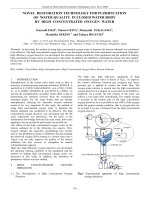
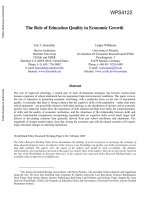

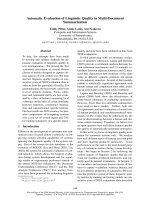
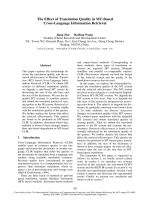


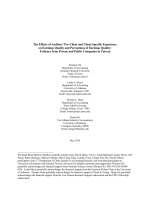
![anis - 2014 - auditors' perceptions of audit firm rotation impact on audit quality in egypt [mafr]](https://media.store123doc.com/images/document/2015_01/06/medium_ljh1420548080.jpg)
